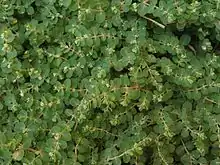Euphorbia chamaesyce
Euphorbia chamaesyce, the prostrate spurge, is an annual plant in the family Euphorbiaceae. It is native to southern North America, and has been introduced and established in other areas of North America and other countries worldwide.
| Euphorbia chamaesyce | |
|---|---|
 | |
| Scientific classification | |
| Kingdom: | Plantae |
| Clade: | Tracheophytes |
| Clade: | Angiosperms |
| Clade: | Eudicots |
| Clade: | Rosids |
| Order: | Malpighiales |
| Family: | Euphorbiaceae |
| Genus: | Euphorbia |
| Species: | E. chamaesyce |
| Binomial name | |
| Euphorbia chamaesyce | |
It is a prostrate plant, with stems growing along the ground up to 45 cm or longer. The leaves are oval in shape, up to one cm long, and arranged in opposite pairs. The flowers are very small, with four greenish white petals. It grows in sunny locations and a variety of soils, and is frequently found as a weed in gardens. The seeds are sharply quadrangular in shape, about 1mm long, and marked with 3 or 4 transverse ridges.[1]
References
- Gleason, A Henry (1963), The new Britton and Brown illustrated flora of the northeastern United States and adjacent Canada, 2, p. 485
| Wikimedia Commons has media related to Euphorbia chamaesyce. |
This article is issued from Wikipedia. The text is licensed under Creative Commons - Attribution - Sharealike. Additional terms may apply for the media files.